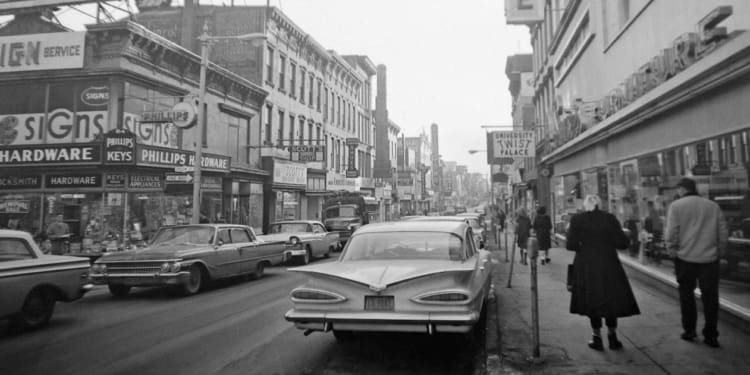Once upon a time, the governor took the visiting princess on a journey to survey his capital city. As they both traveled by car over potholed streets and tenant houses in shambles, the governor was said to be embarrassed.
Is that not how stories with princesses usually go?
The popularity of WMHT-TV’s publication of Mary Paley’s documentary “The Neighborhood That Disappeared” last month reintroduced the Capital District to Albany’s landscape prior to, what had been, a monumental example of government wielding the power of eminent domain. The new documentary illustrates life in Albany’s South End, which was destroyed to make way for the construction of the Empire State Plaza.
Much of the research involved with Paley’s documentary fell upon local historians Ann Pfau and David Hochfelder.
Through the Albany Institute and State Archives, the local historians were able to obtain scores of information, including evidence on 90 percent of the lost neighborhood.
“Someone went down the street, house to house, and we’re not sure as to why,” said Hochfelder, describing pictures they used to create the documentary.
Only a relative handful of pictures, about 300, were filed with the state when property holder’s contested their assessment values. However, more than a thousand photographs were taken independently, placed in a photo album, and ultimately donated to the Albany Institute.
The film also used newspaper photographs from Mary Paley archival film footage, photos from families, archives from the Albany Institute of History and Art and scores of other sources. Hochfelder has since documented the collection of photographs at the Institute as part of an ongoing project spun off from the movie.
“98 Acres in Albany” is the couples’ latest venture that will enable people to take a virtual tour across the neighborhoods, pointing their cursor on a section of town and see pictures of the buildings as they stood in 1962.
“The overall focus is to reconstruct the neighborhood as it was on prior to construction,” said Hochfelder. “The difference from Mary’s film is her focus on the Italian neighborhood, while we want to focus on the whole 98 acres and what it looked like on the eve of demolition.”
Cities left behind
Hochfelder said many cities were forced to address the exodus of residents leaving for the suburbs in the mid-20th Century. Many people found homes in the rural outskirts of their cities.
`Depopulation of the urban core was common country-wide from the 1950s and ‘60s,” said Hochfelder.
Centers of commerce soon followed, leaving many downtown districts left to blight. Municipalities focused on urban renewal projects to coax businesses to stay by promising renewed buildings and roadways, built at the government’s expense.
“Albany’s case was unique in that it wasn’t urban renewal,” said Hochfelder.
Historians have pieced together former New York state Governor Nelson Rockefeller’s wishes to build a stately presence to replace a “shabby capital city,” as Rockefeller described Albany during the Empire State Plaza’s cornerstone ceremony in 1965.
As documented in the New York Times, and later by William Kennedy in “O’Albany,” Rockefeller entertained Princess Beatrix of the Netherlands, as she visited Albany to celebrate the city’s Dutch heritage. While driving through the city, the governor grew conscious of his visitor’s disappointment.
Hochfelder said there is a lot of conjecture as to the Republican governor’s involvement in the overall plan, including a complex agreement between city and county seats of government that involved Albany’s Democratic Party leader Dan O’Connell and mayor Erastus Corning.
Ultimately, the construction of the Empire State Plaza would become one of the largest urban renewal projects in American history. One-third of the city’s ethnic population was displaced. The project razed more than a thousand buildings, dislodged 3,600 households, and closed 350 businesses.
“The South End was much more of a Lower East Side of New York because it was home to many different people who were cheek and jowl to one and other,” former Albany County Assemblyman Jack McEneny said in a prepared statement.
Preserving history
The heritage lost, some of which dates back to the city’s first settlement more than 400 years ago, and the anguish suffered by those directly involved, is something Pfau and Hochfelder wish to address as well.
Pfau said they are applying for grants to aid in their research. Right now, they hope to obtain information as it relates to the residents directly. That’s difficult to achieve, she said, as some names are not included in the city’s 1962 directory.
“The people who fall through the cracks are boarding residents,” said Pfau, who explained that many families resided within many boarding houses. “It’s a work in progress.”
To help piece together the gaps, the researchers turn towards other cities on how they handled similar projects. Hochfelder estimates he spends 30 hours a week on 98 acres — one of two projects occupying his time while on sabbatical from the University of Albany, where he is a history professor.
Both historians envision other municipalities using their research as a means to piece together communities lost through urban renewal. Pfau said that their work so far, and Paley’s documentary, has already helped Albany.
“I think it was the outlet that was needed for a lot of people to move past the anger that has been there all this time,” said Pfau.



